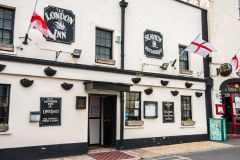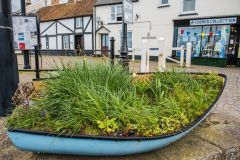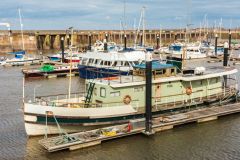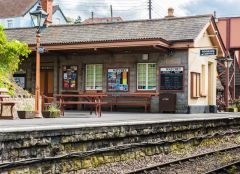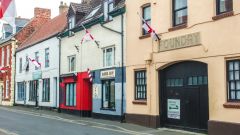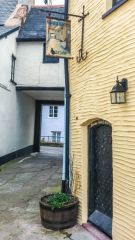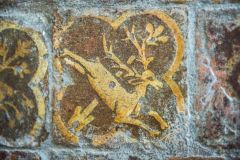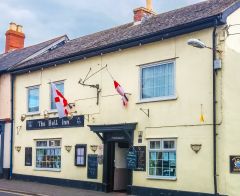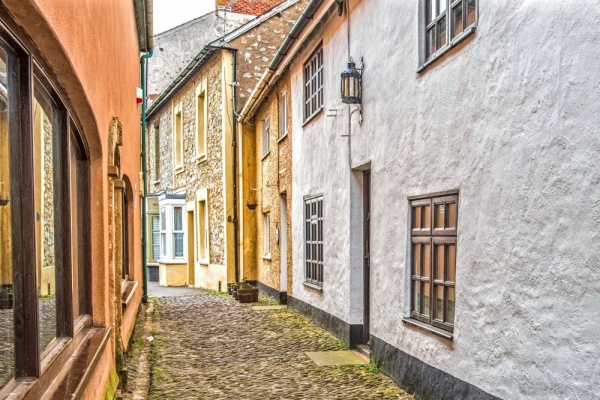
Watchet is a pretty port town in north-western Somerset, built around a picturesque medieval harbour. Watchet really came to prominence in the Saxon period and was important enough to have its own mint. Coins minted in Watchet have been found in Scandinavia, suggesting that they were used to buy off Viking raiders.
History
Alfred the Great transformed Watchet into a burh, or fortified town, one of just 10 burhs in Wessex by the year AD 919. The town was based around the natural harbour, a haven for shipping that was enhanced in the Tudor period when a breakwater was built west of the harbour. The breakwater was initially made of wood, but was later rebuilt in stone.
Ship v Cavalry
Watchet was the scene of a bizarre battle during the Civil War, when a Royalist ship was sent to secure the town for King Charles. The ship stood offshore while the tide ebbed away, leaving only shallow water.
A Parliamentary force of mounted soldiers took advantage of the tide and galloped through the shallow water, their carbines firing volley after volley at the men aboard ship. Though the horses were up to breast level by the time they reached the ship, the carbine fire caused such a panic that the sailors surrendered. This rare encounter may be the only time a ship at sea was captured by men on horseback.
The influence of the local Wyndham family on the history of Watchet cannot be overstated. In 1708 Sir William Wyndham had a new harbour built, and in 1843 a later Wyndham, the 4th Earl of Egremont, had the broad Esplanade built along the harbour. The celebrated maritime artist Thomas Chidgey, a native of Watchet, was inspired by the busy port and the sailing ships he saw there. Several of Chidgeys paintings are on view in the Market House Museum.
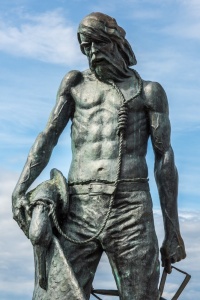
on the Esplanade
Yankee Jack
On the historic Esplanade is a statue of John 'Yankee Jack' Short (1839-1933), a sailor whose renditions of over 50 traditional sea shanties was transcribed by folk-song researcher Cecil Sharpe in the 1920s. When Yankee Jack died in 1933 he was accorded an obituary in The Times - the very first Able Seaman to be recognised in such a way.
Near the statue of Yankee Jack stands a very striking modern statue of Samuel Coleridge's 'The Ancient Mariner'. The statue was erected in 2002 by the Market House Museum Society and was sculpted by Alan Herriot. The statue is a tribute to Coleridge, who lived for many years at nearby Nether Stowey, where his house is now preserved by the National Trust.
Coleridge came to Watchet in 1797 as part of a walking tour. The historic harbour at Watchet inspired him to write his most enduring poem, 'The Rime of the Ancient Mariner'. The first lines of the poem were written at the Bell Inn, where Coleridge was staying with his friend and fellow poet William Wordsworth.
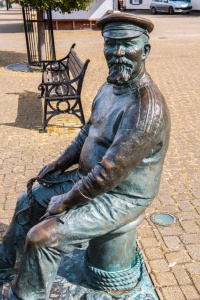
Watchet Market House Museum
Occupying the early 19th-century Market House near the medieval harbour is the Market House Museum. The free museum traces the rich heritage of the Watchet area, including geology, fossils (look for the ichthyosaur skeleton), prehistoric finds, Roman coins, the Saxon mint, and maritime heritage. The museum also celebrates local characters like Yankee Jack.
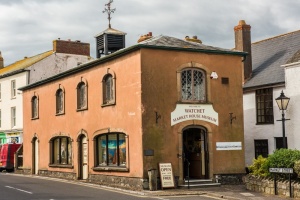
Watchet Boat Museum
In a restored railway shed by Watchet Station is the Watchet Boat Museum. The museum celebrates the maritime heritage of the Watchet area, especially the local 'flatner' boats that plied the shallow waters along the coast. One prize display is the last seagoing flatner boat ever built, but there are also other varieties of boats including turf boats made for transporting peat, and a mud-horse for fishing the local mudflats. The museum building was designed by the famous Victorian engineer Isambard Kingdom Brunel.
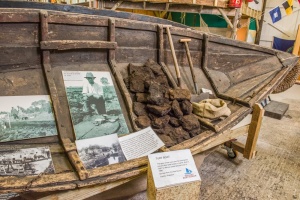
Daws Castle
On the western edge of Watchet, occupying a clifftop site, is the earthwork remains of a Saxon fortress. Daws Castle is said to have been built by Alfred the Great to protect the coast from Viking Raiders. Later under Athelred II there was a Saxon mint established here (alternatively, the mint may have been located at the south end of Swain Street). The clifftop site was later abandoned as the medieval town of Watchet grew up around the harbour. Today there are few visible remains of the castle beyond low earthen banks.
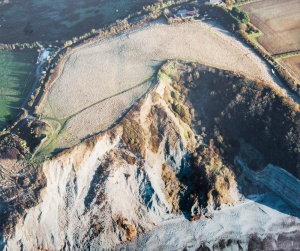
St Decuman's Holy Well
Christianity was brought to the Watchet area in the 7th century by Decuman, a Welsh missionary from Pembrokeshire. Decuman is said to have floated across the Bristol Channel on his cloak, accompanied by a cow. The local pagan residents did not take kindly to his preaching and one of them struck off his head, whereupon a spring gushed forth from the place his head landed.
The saint then picked up his head, washed it in the healing waters, and put it back on his shoulders. An alternative version of the story says that the well was already considered a holy place long before Decuman's arrival. Today the well is a tranquil place, with water running out of a simple stone well-head and through stone-lined channels to a series of three small pools.
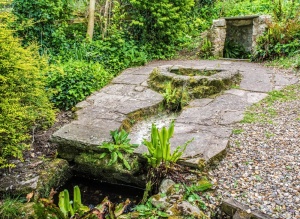
St Decuman's Church
The holy well lies just below the churchyard of a medieval church built on the site of a church erected by Decuman and his followers. Most of the church is 13th century, with 15th-century additions. Look for a wonderful collection of memorial brasses to the Wyndham family, lords of the manor, as well as a restored medieval screen.
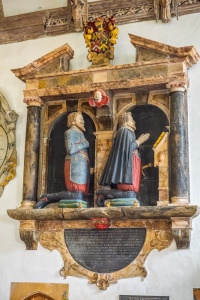
in St Decuman's Church
There are two traditional inns; the London Inn and The Bell Inn. The Bel is the oldest pub in Watchet, built in the 16th century, and retaining many of its period features. Look for the old serving hatch in the inn wall that links directly to the Old Foundry in Swain Street. Beer was passed directly through the hatch to workers in the Foundry. Beneath the pub runs an old tunnel, supposedly used by smugglers. The London Inn is a relative newcomer, built in the late 18th century, with a pair of large oriel windows facing the harbour.
On Swain Street is the West Somerset Hotel, dating to the early 19th century. Aside from St Decuman's Church, there are several other historical churches in the town. On Brendon Road is the Baptist Church, dating to 1824. The church is fronted by Art Deco railings and behind the building is a late 19th century Sunday School building. On Harbour Road is the Methodist Chapel, built in 1871.
The only thatched buildings left in Watchet are the picturesque Waterloo Cottages (Nos 7,8, and 9 Mill Street). The cottages probably date to the late 17th century. The most important historic building is Kentsford Farmhouse off Brendon Road. Kentsford was a late medieval building that was the home of the Wyndham family, lords of the manor. It was rebuilt in the 17th century and is still a private home.
Watchet is so full of historic interest! It makes a wonderful place to explore, and an excellent base for visiting the north coast of Somerset.
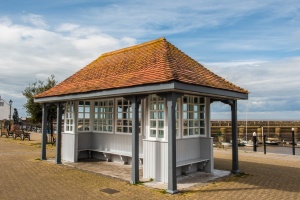
About Watchet
Address: B3191,
Watchet,
Somerset,
England
Attraction Type: Town
Location: On the B3191 coastal road, just off the A39 north of Williton.
Location map
OS: ST071433
Photo Credit: David Ross and Britain Express
HERITAGE
 We've 'tagged' this attraction information to help you find related historic attractions and learn more about major time periods mentioned.
We've 'tagged' this attraction information to help you find related historic attractions and learn more about major time periods mentioned.
Historic Time Periods:
Medieval
Prehistoric
Roman
Saxon
Tudor
Victorian
Find other attractions tagged with:
13th century (Time Period) - 15th century (Time Period) - 16th century (Time Period) - 17th century (Time Period) - 18th century (Time Period) - 19th century (Time Period) - 7th century (Time Period) - Alfred the Great (Person) - castle (Architecture) - Civil War (Architecture) - holy well (Historical Reference) - Medieval (Time Period) - Parliamentary (Historical Reference) - Prehistoric (Time Period) - Roman (Time Period) - Royalist (Person) - Saxon (Time Period) - Tudor (Time Period) - Victorian (Time Period) - Viking (Historical Reference) - William Wordsworth (Person) -
NEARBY HISTORIC ATTRACTIONS
Heritage Rated from 1- 5 (low to exceptional) on historic interest
Watchet Market House Museum - 0 miles (Museum) ![]()
Watchet Boat Museum - 0.1 miles (Museum) ![]()
Daws Castle - 0.5 miles (Castle) ![]()
St Decuman's Holy Well - 0.6 miles (Historic Church) ![]()
Watchet, St Decuman's Church - 0.6 miles (Historic Church) ![]()
Williton, St Peter's Church - 1.7 miles (Historic Church) ![]()
Bakelite Museum - 1.7 miles (Museum) ![]()
Old Cleeve, St Andrew's Church - 2.1 miles (Historic Church) ![]()
